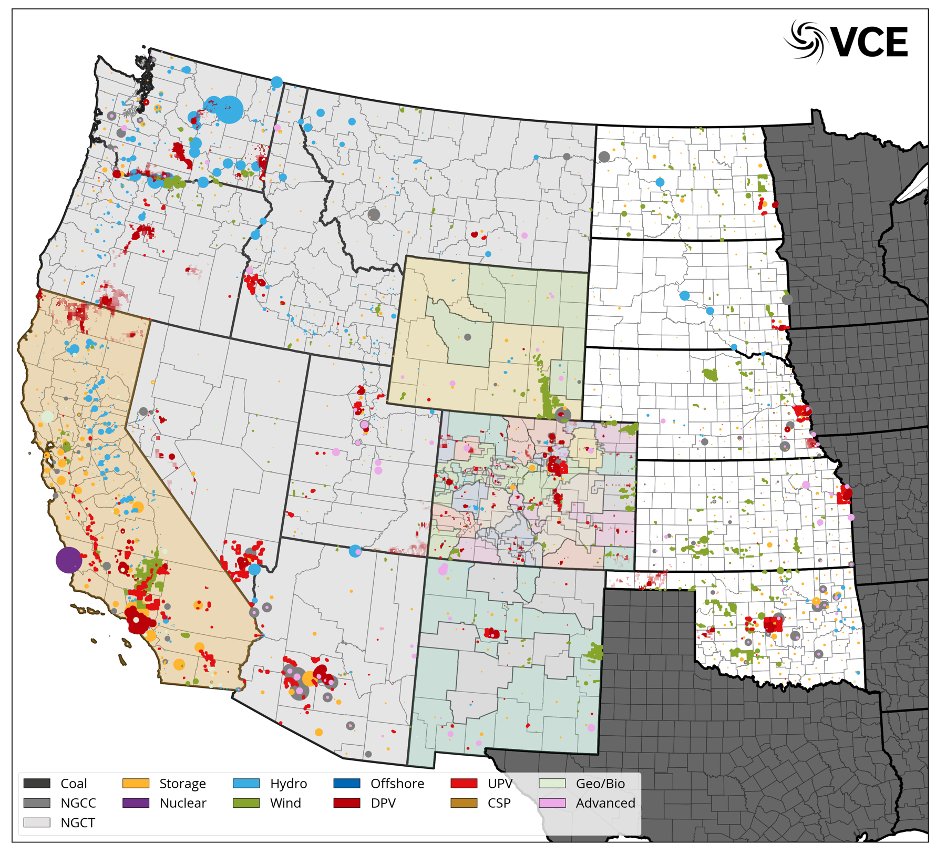
🧵🧵 ⚡️NEW STUDY RELEASE⚡️ 🧵🧵
Colorado can reduce electricity cumulatively save $1.8 billion by 2040. At the same time, it can grow the electricity job market by 70,000 and reduce GHG emissions by 75% from 2005 levels.
@holycrossenergy @IREAcoop @DrChrisClack @achoukulkar
Colorado can reduce electricity cumulatively save $1.8 billion by 2040. At the same time, it can grow the electricity job market by 70,000 and reduce GHG emissions by 75% from 2005 levels.
@holycrossenergy @IREAcoop @DrChrisClack @achoukulkar

It can do all this by:
1) Coordinating transmission planning across Colorado;
2) Designing transmission tariffs and access spread across Colorado;
#transmission
1) Coordinating transmission planning across Colorado;
2) Designing transmission tariffs and access spread across Colorado;
#transmission

3) Ensuring all utilities and cooperatives join the same Energy Imbalance Market (best for whole US is when all CO joins the WEIM);
4) Deploy wind, solar, and storage throughout Colorado;
5) Sell the excess Coloradan wind and solar to other states in the West.
#cleanenergy

4) Deploy wind, solar, and storage throughout Colorado;
5) Sell the excess Coloradan wind and solar to other states in the West.
#cleanenergy


Press Release -
vibrantcleanenergy.com/wp-content/upl…
Study Report -
vibrantcleanenergy.com/wp-content/upl…
Study Presentation -
vibrantcleanenergy.com/wp-content/upl…
Model Output Data -
vibrantcleanenergy.com/wp-content/upl…
#renewableenergy #climatechange #transmission
#publicpolicy #cleanenergy #wind #solar #storage

vibrantcleanenergy.com/wp-content/upl…
Study Report -
vibrantcleanenergy.com/wp-content/upl…
Study Presentation -
vibrantcleanenergy.com/wp-content/upl…
Model Output Data -
vibrantcleanenergy.com/wp-content/upl…
#renewableenergy #climatechange #transmission
#publicpolicy #cleanenergy #wind #solar #storage


The modeling for the study suggests that the electricity supply in Colorado will dramatically change over the next to decades. There will be more wind, solar and storage. These will be assisted by DERs and natural gas. The state will become a net exporter of electricity. 



The increase in generation from VREs and the integration of storage causes the system to behave fundamentally differently to today's system. This requires re-thinking around every aspect of the operations. For example, a new metric "System Strain" shows the value of storage. 



When more VREs are introduced into the Colorado footprint, the variability of supply increases. This leads to shifts in when reliability is tested. The WIS:dom®-P model ensures that demand is met for each 5-minute interval for all years at all locations, without fail. 



The combination of distributed solar and storage change how the utilities' provide power as the demand they need to supply can change and flex to accommodate the fluxes in the utility-scale VREs. This results in peak demand reduced across Colorado of 20%. 

The WIS:dom®-P model must maintain planning reserve margins and load following reserves for all entities in CO (and WECC+SPP). There are different ways to evaluate the contribution of VREs and storage. The model can do many of them, and these metrics can impact deployments. 







The capacity and generation mix are completely altered from 2018 through 2040 for Colorado (the model must meet the HB19-1261 legislation); as is the transmission import and exports. This is the WIS:dom®-P model able to blend the macro- and micro- scale for coordinated planning. 



Detailed technical documentation is available for WIS:dom®-P here: vibrantcleanenergy.com/wp-content/upl…
Descriptions of the input datasets for the modeling is included in the study report. How they are used is in the technical documentation.


Descriptions of the input datasets for the modeling is included in the study report. How they are used is in the technical documentation.



Critical inputs for the modeling include the siting potential & screening for construction limitations on critical & endangered lands. Also, there are regional costs to impute, weather impacts on transmission, political & societal contracts, and others. Read report for more. 







The modeling was performed at high spatial and temporal granularity (3-km, minutely) across the Western and SPP grids from 2018 through 2040. It included transmission power flow, with losses (and dynamic line rating based on weather conditions). 

To conclude: The modeling indicates that GHGs can be reduced significantly under all scenarios; costs can be lowered for all customers; more jobs can be created all at the same time. Colorado can amplify its benefits by a unified transition to a single EIM (then to an RTO). 

Encore: The modeling did not include high electrification or economy-wide net zero emission goals. We will be releasing a national study soon on this very topic. Spoiler: the results from this study are robust under wider clean energy targets, indeed, the benefits magnify. 

• • •
Missing some Tweet in this thread? You can try to
force a refresh


